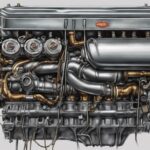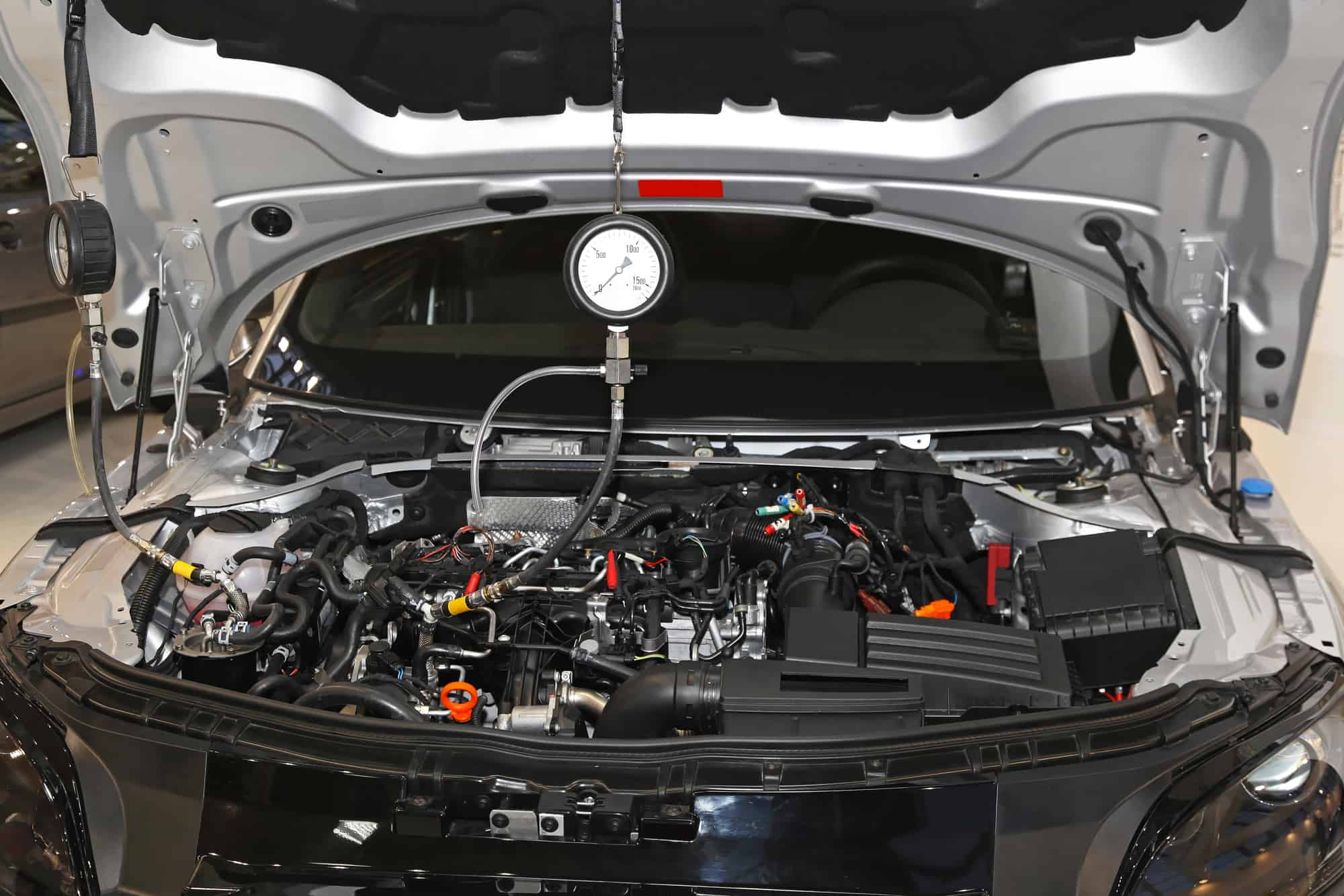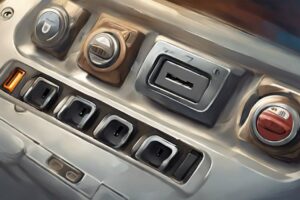The P0300 OBD-II Trouble Code is a diagnostic code that indicates a random or multiple cylinder misfire has been detected in a vehicle’s engine. This code is one of the most common OBD-II codes, and it can be caused by a variety of issues. When this code appears, it means that the vehicle’s computer has detected an engine misfire that is random and/or appearing on multiple cylinders.
The P0300 code can be triggered by a range of issues, including faulty spark plugs, damaged fuel injectors, broken wire connections, a bad oxygen sensor, a defective catalytic converter, a faulty head gasket, or vacuum leaks.
The code doesn’t provide any insight into which cylinder(s) might be misfiring or why, making it a vague diagnosis.
(As an Amazon Associate we earn from qualifying purchases.)
Regardless of the cause, it is important to address a P0300 code occurrence promptly to prevent damage to the vehicle’s engine.
What Does Engine Code P0300 Mean?
The P0300 code is a diagnostic trouble code (DTC) that indicates a random or multiple cylinder misfire has been detected in the engine.
This code is often accompanied by other misfire codes, such as P0301, P0302, P0303, P0304, P0305, P0306, P0307, or P0308.
A misfire occurs when the fuel in a cylinder fails to ignite properly, causing the engine to run rough and possibly stall.
The P0300 code indicates that the misfire is random and/or occurring on multiple cylinders.
This can be caused by a variety of issues, including faulty spark plugs, ignition coils, fuel injectors, or vacuum leaks.
How Serious is Code P0300?
Code P0300 indicates that there is a random or multiple cylinder misfire detected in the engine. This can be a serious issue if left unaddressed as it can cause damage to other parts of the engine.
The misfire can be caused by a variety of issues, such as faulty spark plugs, ignition coils, fuel injectors, or even a clogged fuel filter. If the cause of the misfire is not addressed, it can lead to decreased fuel efficiency, reduced engine power, and even engine damage.
In some cases, the issue may be a simple fix such as replacing a faulty spark plug or ignition coil. However, in more severe cases, the repair may be more complex and costly. It is important to address the issue promptly to prevent any further damage to the engine and to ensure the vehicle is running at its best.
What Causes diagnostic code P0300?
There are several potential causes of the P0300 code, including:
1. Ignition System Problems
Ignition system problems, such as a faulty distributor, worn spark plugs, or damaged ignition coils, can cause the engine to misfire and trigger the P0300 code. If the spark plugs are worn or damaged, they may not ignite the fuel properly, which can cause a misfire. Similarly, if the ignition coils are damaged, they may not be able to provide enough voltage to the spark plugs, which can also cause a misfire.
2. Fuel Delivery Issues
Fuel delivery issues, such as a weak fuel pump or clogged fuel injectors, can also cause the engine to misfire and trigger the P0300 code. If the fuel pump is weak, it may not be able to deliver enough fuel to the engine, which can cause a misfire. Similarly, if the fuel injectors are clogged or not functioning properly, they may not be able to deliver the correct amount of fuel to the engine, which can also cause a misfire.
3. Engine Mechanical Problems
Engine mechanical problems, such as a failed head gasket, loose timing chain, or low compression in one or more cylinders, can cause the engine to misfire and trigger the P0300 code. If the head gasket fails, it can allow coolant to leak into the combustion chamber, which can cause a misfire. Similarly, if the timing chain is loose, it can cause the timing to be off, which can also cause a misfire. Low compression in one or more cylinders can also cause a misfire, as the fuel may not ignite properly if there is not enough pressure in the cylinder.
Other possible causes of the P0300 code include vacuum leaks, damaged or malfunctioning sensors (such as the MAF sensor or oxygen sensors), and issues with the engine’s computer or wiring. It’s recommended to have a professional mechanic diagnose and repair the issue to ensure that it is properly resolved.
Specific causes of code P0300 include:
| Cause Of P0300 | Description |
|---|---|
| Faulty spark plugs or ignition coils | Worn or damaged spark plugs or faulty ignition coils can cause the engine to misfire and trigger the P0300 code. |
| Clogged or dirty fuel injectors | Clogged or dirty fuel injectors can cause the engine to misfire by not delivering enough fuel to the engine. |
| Low fuel pressure | A weak fuel pump or clogged fuel filter can cause low fuel pressure, which can cause the engine to misfire and trigger the P0300 code. |
| Vacuum leaks | Vacuum leaks in the engine can cause the air-fuel mixture to be too lean, which can cause the engine to misfire and trigger the P0300 code. |
| Faulty mass airflow (MAF) sensor | A faulty MAF sensor can cause the engine to misfire by not accurately measuring the amount of air entering the engine. |
| Faulty crankshaft position sensor | A faulty crankshaft position sensor can cause the engine to misfire by not accurately measuring the position of the crankshaft. |
| Timing chain or belt issues | Timing chain or belt issues can cause the engine’s timing to be off, which can cause the engine to misfire and trigger the P0300 code. |
| Engine compression problems | Low compression in one or more cylinders can cause the engine to misfire and trigger the P0300 code. |
Symptoms of a P0300 Code
When the check engine light comes on, it can be a sign of a variety of issues with the engine.
One possible cause is a P0300 code, and if this is the case it will usually be accompanied by an engine misfire.
Here are some common symptoms of a P0300 code.
Symptom 1. Check Engine Light
The most common symptom of the P0300 code is the illumination of the check engine light on the dashboard. This light is designed to alert the driver that there is an issue with the engine that needs to be addressed.
When the ECU detects a misfire in the engine, it will trigger the P0300 code and illuminate the check engine light on the dashboard. The check engine light can be a solid light or a blinking light, depending on the severity of the misfire.
A solid light indicates a less severe misfire, while a blinking light indicates a more severe misfire that can could cause damage to the engine or catalytic converter.
Symptom 2. Engine Misfires
Engine misfires are another common symptom of the P0300 code.
A misfire occurs when one or more cylinders in the engine fail to ignite properly, which can cause a rough running engine, a loss of power, and poor fuel economy. When the engine ECU detects a misfire in the engine, it will trigger the P0300 code and illuminate the check engine light on the dashboard.
The misfire can be caused by a variety of issues, including problems with the ignition system, fuel delivery system, engine mechanical problems, or other issues.
It’s important to note that the P0300 code is a general code that does not identify which cylinder is misfiring, so it’s recommended to have a professional mechanic diagnose and repair the issue to ensure that it is properly resolved.
Symptom 3. Rough Engine Idle
A rough idle is another symptom of the P0300 code.
When one or more cylinders in the engine fail to ignite properly, it can cause the engine to run roughly and vibrate, which can be felt as a rough idle. The engine may also feel like it is shaking or vibrating, and the RPMs may fluctuate.
The rough idle is caused by the misfire, which can be caused by a variety of issues, including problems with the ignition system, fuel delivery system, engine mechanical problems, or other issues.
Symptom 4. Engine Stalling
Diagnostic code P0300 triggers when an engine stalls because this code indicates that there is a random misfire in the engine. When one or more cylinders in the engine fail to ignite properly, it can cause the engine to stall, which means it suddenly stops running, often without warning.
The misfire can be caused by a variety of issues, including problems with the spark plugs, ignition coils, fuel injectors, or other components.
When the ECU detects a misfire in the engine, it will trigger the P0300 code and illuminate the check engine light on the dashboard. The code is triggered when the ECU detects a misfire in more than one cylinder, or when it cannot determine which cylinder is misfiring. This is why the code is referred to as a “random misfire” code.
Engine stalling is a common symptom of the P0300 code, and it can be dangerous, especially if it occurs while driving at high speeds.
Symptom 5. Lack of Power
A lack of power is another symptom of the P0300 code. When one or more cylinders in the engine fail to ignite properly, it can cause a loss of power, which means the engine is not able to produce the power needed to accelerate or maintain speed.
A lack of engine power is a common symptom of the P0300 code, and it can often be accompanied by a decrease in fuel economy.
Other possible symptoms of the P0300 code include a rough running engine at high speeds, a smell of gasoline in the exhaust, and difficulty starting the engine.
How Does P0300 Affect Vehicle Performance and Drivability?
A P0300 code can have a noticeable effect on a vehicle’s performance and drivability. The misfire can cause the engine to run poorly, resulting in a rough ride and decreased fuel efficiency. In severe cases, the engine may stall or shut off while driving, which can be dangerous.
If left untreated, a P0300 code can also cause damage to other engine components, such as the catalytic converter. This can result in costly repairs down the line. It’s important to address a P0300 code as soon as possible to prevent further damage to the vehicle and ensure safe driving.
Can Random/Multiple Cylinder Misfires Cause Individual Cylinder Misfires?
Yes, random or multiple cylinder misfires can cause individual cylinder misfires. When a random or multiple cylinder misfire occurs, it can impact the performance of individual cylinders, resulting in a specific cylinder misfire code like “troubleshoot cylinder 3 misfire code.” It’s important to address all misfires to ensure smooth engine operation.
Are Random/Multiple Cylinder Misfires Related to Specific Cylinder Misfire Issues?
When diagnosing cylinder 2 misfire, it’s important to consider if random/multiple cylinder misfires are related. While specific cylinder misfire issues can indicate a problem with one particular cylinder, random misfires might point to a broader issue with the engine’s ignition system or fuel delivery.
How Does the P0300 Trouble Code Differ from the P0600 Error Code?
The P0300 trouble code typically indicates random misfiring in the engine, while the P0600 error code points to a communication error between the PCM and other control modules. The causes and solutions for error code P0600 may involve issues with the PCM’s internal circuits or software, necessitating diagnostic testing and potential replacement.
What Next – How To Diagnose And Repair Error Code P0300
When a vehicle’s check engine light comes on, it can be a sign of many possible issues. One of the most common is a P0300 code, which indicates a random or multiple cylinder misfire detected.
While this code can be caused by a variety of issues, a systematic diagnostic process can help identify the root cause and fix the problem.
The first step in diagnosing a P0300 code is to use an OBD-II scan tool to retrieve the code and any other related codes. This tool can also provide valuable data on the vehicle’s sensors and systems, such as fuel trim, oxygen sensor readings, and more. Without this tool, it can be difficult to identify the cause of the misfire and other issues that may be present.
Once the code has been retrieved, the next step typically involves checking various ignition, fuel, and mechanical components in a specific order to rule out possible causes and pinpoint the root issue.
Here are some steps that are commonly carried out when trying to repair P0300:
1. Checking Ignition System Components
The ignition system is a common culprit of misfires, so it’s important to check components such as spark plugs, ignition coils, and spark plug wires. A faulty ignition coil, for example, can cause a misfire in a specific cylinder. Checking these components can help identify any issues and determine if they need to be replaced.
2. Evaluating Fuel System Components
The fuel system is another area to check when diagnosing a P0300 code. Fuel injectors, fuel pressure, and fuel filters can all contribute to a misfire. Checking these components can help identify any issues and determine if they need to be replaced or repaired.
3. Examining Engine Mechanical Conditions
Engine mechanical conditions can also contribute to a misfire. Compression issues, for example, can cause a misfire in a specific cylinder. Checking engine compression and other mechanical conditions can help identify any issues and determine if they need to be repaired.
4. Analyzing Engine Control Unit (ECU) Data
Finally, analyzing engine control module (ECM) data can provide valuable insights into the cause of the misfire. This data can include fuel trim readings, oxygen sensor readings, and more. Analyzing this data can help identify any issues and determine if they need to be addressed.
Overall, diagnosing a P0300 code requires a systematic approach and attention to detail. By following a step-by-step guide and checking various ignition, fuel, and mechanical components, it’s possible to identify the root cause of the misfire and fix the issue.
Potential Causes and Solutions for P0300 Code
When a P0300 code is detected, it indicates that the engine is experiencing random or multiple cylinder misfires.
This can be caused by a variety of issues, including problems with the ignition system, fuel system, engine mechanical faults, or rarely ECU programming or software updates. Here are some potential causes and solutions for the P0300 code:
1. Ignition System Issues
Ignition system problems are one of the most common causes of the P0300 code. This can include a bad distributor, worn spark plugs, or faulty ignition coils. To diagnose ignition system issues, the mechanic will typically check the spark plugs and coils for signs of wear or damage. If any components are found to be faulty, they will need to be replaced.
2. Fuel System Problems
Fuel delivery issues can also cause the P0300 code. This can include a weak fuel pump, clogged fuel injectors, or a dirty fuel filter. To diagnose fuel system problems, the mechanic will typically check the fuel pressure and inspect the fuel injectors. If any components are found to be faulty, they will need to be replaced.
3. Engine Mechanical Faults
Engine mechanical problems can also cause the P0300 code. This can include a failed head gasket, loose timing chain, or damaged piston rings. To diagnose engine mechanical faults, the mechanic will typically perform a compression test and inspect the engine for signs of wear or damage. If any components are found to be faulty, they will need to be repaired or replaced.
4. ECU Programming or Software Updates
In some cases, the P0300 code can be caused by a problem with the ECM programming or software. To diagnose this issue, the mechanic will typically perform a software update or reprogram the ECM. This can be done using specialized diagnostic tools and software.
How Cylinder Misfires are Detected
A misfire is an event where the air-fuel mixture in one or more cylinders fails to ignite properly. The OBD-II system is designed to detect misfires and alert the driver with a diagnostic trouble code (DTC) such as P0300. The system uses various sensors to monitor the engine’s performance and detect anomalies that could indicate a misfire.
The most common sensor used to detect misfires is the crankshaft position sensor. This sensor monitors the rotation of the crankshaft and sends a signal to the engine control module (ECM) indicating the position of each piston. If the ECM detects a variation in the crankshaft signal that is outside of the normal range, it will assume that a misfire has occurred.
Other sensors that can be used to detect misfires include the camshaft position sensor, the oxygen sensor, and the knock sensor. These sensors can detect anomalies in the engine’s performance that could indicate a misfire, such as a sudden drop in engine speed or a change in the air-fuel ratio.
Identifying Specific Misfiring Cylinders
Once the OBD-II system has detected a misfire, it will set a diagnostic trouble code such as P0300 to indicate that a misfire has occurred. However, this code does not provide any information about which cylinder is misfiring or why.
To identify the specific misfiring cylinder, the OBD-II system uses a process called misfire detection. This process involves monitoring the performance of each cylinder and comparing it to the others to detect anomalies that could indicate a misfire.
There are several methods that can be used to identify misfiring cylinders, including:
- Cylinder identification by firing order: This method involves identifying the misfiring cylinder based on its position in the engine’s firing order. For example, if the engine has a firing order of 1-3-4-2, and the misfire is detected on the third cylinder, the OBD-II system will set a diagnostic trouble code of P0303 to indicate that cylinder 3 is misfiring.
- Cylinder identification by power balance: This method involves measuring the power output of each cylinder and comparing it to the others to detect anomalies that could indicate a misfire. If one cylinder is producing less power than the others, it could be an indication that it is misfiring.
- Cylinder identification by waveform analysis: This method involves analyzing the waveform of the crankshaft sensor signal to identify anomalies that could indicate a misfire. By comparing the waveform of each cylinder to the others, the OBD-II system can identify the specific cylinder that is misfiring.
Overall, the OBD-II system is an effective tool for detecting misfires and identifying the specific cylinder that is misfiring. By monitoring the engine’s performance and comparing it to the expected values, the system can detect anomalies that could indicate a misfire and alert the driver with a diagnostic trouble code.
How much does it cost to repair Error Code P0300?
The cost to repair Error Code P0300 can vary depending on the severity of the issue and the type of vehicle. Here are some factors that can affect the cost:
- Labor Costs: The cost of labor can vary depending on the mechanic’s hourly rate and the amount of time it takes to diagnose and repair the issue. Some mechanics may charge a diagnostic fee to determine the root cause of the problem before providing a repair estimate.
- Parts Costs: If parts need to be replaced to fix the issue, the cost can vary depending on the type of parts needed and the make and model of the vehicle. In some cases, OEM (original equipment manufacturer) parts may be more expensive than aftermarket parts.
- Severity of the Issue: If the issue is minor, such as a faulty spark plug or ignition coil, the repair cost may be relatively low. However, if the issue is more severe, such as a damaged engine or transmission, the repair cost can be much higher.
According to RepairPal, the estimated cost to repair Error Code P0300 ranges from $80 to $320. This estimate includes the cost of labor and parts. However, it’s important to note that this is only an estimate and the actual cost can vary depending on the factors mentioned above.
It’s also worth noting that if the issue is not resolved promptly, it can lead to further damage to the engine or other components of the vehicle, which can result in even higher repair costs. Therefore, it’s important to address Error Code P0300 as soon as possible to prevent further damage and higher repair costs.
















My car recently started running roughly and then the check engine light came on. I used an OBD-II scanner and it showed the P0300 code, indicating random or multiple cylinder misfires. I’m not very knowledgeable about car repairs, but I want to try and understand the issue before taking it to a mechanic. Could you please explain how I can identify which cylinder is misfiring? Is there a way for me to narrow down the problem further without specialized equipment?
I recently noticed my check engine light came on, and my car started running rough, almost like it was struggling to maintain power, especially during acceleration. Could this be a sign of the P0300 code, and what should be my first step in addressing it to avoid further damage?